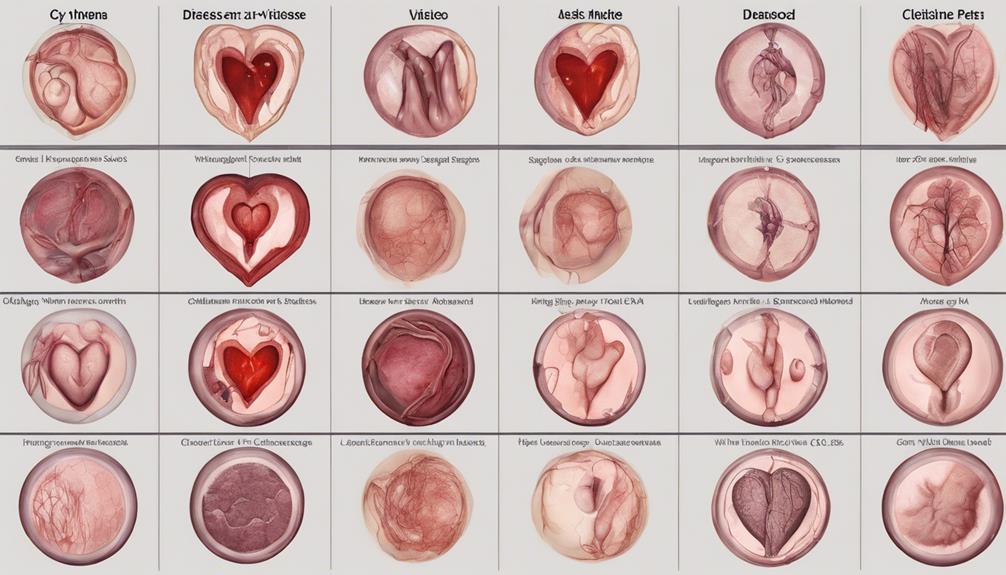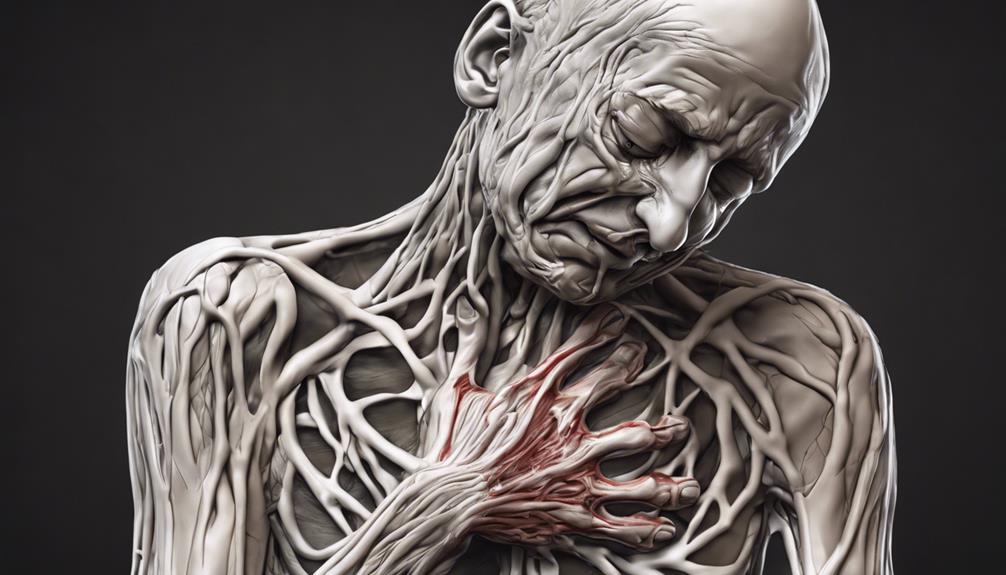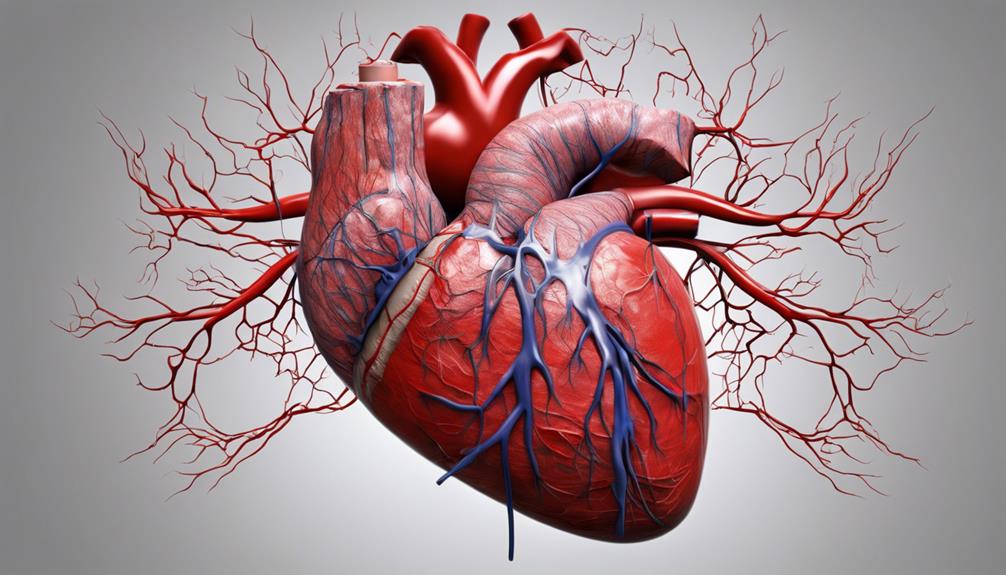Have you ever thought about the relationship between the health of your skin and your heart?
Surprisingly, there are ten skin signs that could be pointing to underlying heart disease.
These subtle indicators might be more telling than you realize, offering a window into your cardiovascular well-being.
Let's explore these signs together and uncover the importance of paying attention to what our skin might be revealing about our heart's condition.
Key Takeaways
- Blue or purple skin may indicate low oxygen levels in blood.
- Red, scaly patches may relate to psoriasis and heart risks.
- Yellowish waxy bumps signal high cholesterol and heart disease risk.
- Red pinpoint rash could indicate scarlet fever and heart complications.
Skin Discoloration and Swelling
Skin discoloration and swelling can serve as important visual indicators of potential heart disease, signaling underlying issues that require medical attention. Blue or purple skin discoloration may point to insufficient oxygen in the blood, suggesting a possible blockage in blood vessels related to heart conditions. This sign underscores the importance of monitoring heart health and seeking appropriate medical care.
Likewise, swelling in the lower legs and feet, termed edema, could indicate fluid buildup due to heart diseases. Edema serves as a crucial sign of potential heart and cardiovascular issues, emphasizing the need for further evaluation and management of heart health.
Understanding these skin signs in relation to heart disease is vital for early detection and intervention. Recognizing these visual cues, such as skin discoloration and swelling, can lead to timely diagnosis and treatment, potentially preventing further complications. Regular monitoring of cholesterol levels, maintaining heart health, and promptly addressing any concerning symptoms can significantly impact overall well-being and quality of life.
Red, Scaly Patches

Red, scaly patches on the skin commonly indicate the presence of psoriasis, a chronic inflammatory condition affecting various body parts. Psoriasis accelerates the turnover of skin cells, leading to the formation of red, flaky patches that can be itchy and uncomfortable.
The most prevalent form of psoriasis, plaque psoriasis, manifests as raised, red patches covered with silvery scales. It's crucial to address psoriasis promptly as severe cases are linked to an increased risk of heart disease and stroke due to chronic inflammation.
Managing psoriasis effectively not only alleviates skin symptoms but also plays a significant role in reducing the potential for cardiovascular complications and enhancing overall health. Seek medical advice if you notice persistent red patches with scales on your skin, as early intervention and proper care are essential in managing psoriasis and its associated risks.
Yellowish Waxy Bumps
Yellowish waxy bumps on the skin may signal elevated cholesterol levels, indicating a potential risk for heart disease. These bumps, medically termed xanthomas, result from the accumulation of fats such as cholesterol. Typically, xanthomas manifest around the eyes, on the palms, or the lower legs. Their presence could suggest an increased risk of heart disease and atherosclerosis, underscoring the importance of consulting a healthcare provider promptly for evaluation and management.
| Key Points | Details |
|---|---|
| Identification | Yellowish waxy bumps called xanthomas on skin. |
| Association with Cholesterol | Indicates high cholesterol levels and potential heart disease risk. |
| Common Locations | Around eyes, on palms, or lower legs. |
These skin manifestations should not be overlooked, as they can serve as valuable indicators of underlying health issues. Seeking guidance from a healthcare provider for thorough evaluation and appropriate management is crucial when yellowish waxy bumps are present.
Yellow-Orange Raised Bumps

When observing yellow-orange raised bumps on the skin, it's crucial to recognize these as potential indicators of cholesterol deposits and high cholesterol levels. These waxy growths can signify underlying health conditions, including high cholesterol or diabetes. Dermatologists play a vital role in diagnosing and treating these yellow-orange raised bumps, which are often seen around the lower legs, eyes, or palms. Elevated triglyceride levels may also be linked to the presence of these bumps, necessitating interventions to lower triglycerides and address heart-related issues promptly.
Identifying and addressing these skin signs through medical evaluation is essential for managing potential heart disease risks. Therefore, individuals noticing these yellow-orange raised bumps should seek professional help to assess their cholesterol and triglyceride levels. Early detection and intervention can lead to better management of high cholesterol levels and associated cardiovascular concerns. Consulting healthcare providers for proper diagnosis and treatment is key to maintaining heart health in the presence of these skin manifestations.
Red Pinpoint Rash
The red pinpoint rash associated with scarlet fever, caused by group A Streptococcus bacteria, presents as small, red spots covering the body and is indicative of the bacterial infection.
In children with scarlet fever, this distinctive skin rash often accompanies symptoms such as flushed cheeks, a red tongue (known as strawberry tongue), and high fever.
Prompt treatment of scarlet fever is essential to prevent complications like Rheumatic heart disease, which can have serious consequences.
Recognizing the red pinpoint rash as a sign of scarlet fever is crucial for early intervention and effective management of the underlying bacterial infection.
Monitoring individuals, especially children, who exhibit this specific skin manifestation along with other symptoms associated with scarlet fever is vital in providing timely medical care and reducing the risk of potential complications.
Therefore, being vigilant about recognizing the red pinpoint rash in the context of scarlet fever is paramount for ensuring proper treatment and preventing adverse outcomes.
Frequently Asked Questions
What Are the 4 Signs Your Heart Is Quietly Failing?
We'll outline four key signs that may indicate your heart is quietly failing.
Shortness of breath with minimal exertion, swelling in legs or abdomen, sudden weight gain due to fluid retention, and fatigue that hinders daily activities can all be red flags for heart failure.
It's crucial to pay attention to these symptoms and seek medical attention promptly if you experience them.
What Are at Least 3 Early Warning Signs of Heart Disease?
We've noticed early warning signs of heart disease manifesting in various skin changes. Clubbing of nails, bluish or purple net-like patterns on the skin, and yellowish or orange-ish deposits under the skin can all signal underlying heart issues.
Recognizing these skin signs can prompt timely medical intervention and possibly prevent heart-related complications. It's crucial to monitor and address these warning signs promptly for better heart health outcomes.
What Are the Skin Manifestations of Heart Disease?
We can identify various skin manifestations in heart disease. These include stasis dermatitis, psoriasis, xanthelasmas, and eruptive xanthomas.
Stasis dermatitis presents as red, dry, itchy skin due to venous insufficiency. Psoriasis shows as red, scaly patches and is linked to heart disease risk.
Xanthelasmas indicate lipid accumulation, while eruptive xanthomas appear as waxy bumps due to high triglycerides. Recognizing these signs can aid in early detection and management of heart conditions.
What Are the Facial Signs of Heart Problems?
Facial signs of heart problems can be crucial indicators of underlying cardiovascular issues. These signs may include:
- Bluish discoloration of the lips and cheeks
- Swollen lips
- Rash on the face
- Changes in facial skin color
- Painless bumps or growths around the eyes
- Red or purple lines under the fingernails
These visual cues can provide valuable insights into potential heart conditions and require prompt evaluation by healthcare professionals.
Conclusion
In conclusion, recognizing skin signs of heart disease is crucial for early detection and intervention.
One striking statistic reveals that up to 50% of patients with infective endocarditis exhibit skin symptoms, underscoring the importance of thorough examination and awareness of these indicators.
By paying attention to these clues, individuals can take proactive steps to protect their heart health and seek timely medical attention when needed.








